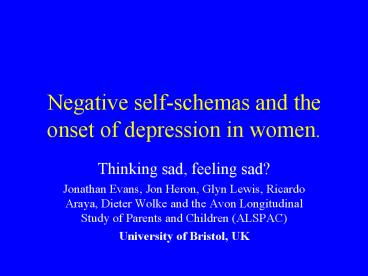Negative selfschemas and the onset of depression in women. PowerPoint PPT Presentation
Title: Negative selfschemas and the onset of depression in women.
1
Negative self-schemas and the onset of depression
in women.
- Thinking sad, feeling sad?
- Jonathan Evans, Jon Heron, Glyn Lewis, Ricardo
Araya, Dieter Wolke and the Avon Longitudinal
Study of Parents and Children (ALSPAC) - University of Bristol, UK
2
What is cognitive theory of depression?
- Aaron T Beck a psychoanalyst.
- Previously - depressed moods arise because of
subconscious processes conflict, deficit. - Cognitive theory reverses
- the feeling thoughts.
- Thoughts are not just a symptom of depression
they are causal.
3
Two forms
- Automatic negative thoughts
- Schema
4
What are schema?
- stable characteristics of personality that
cause depression by distorting the selection,
encoding, organisation and evaluation of
environmental stimuli (Gotlib Hammen, 1992)
5
Are schema latent?
- Even though these attitudes (or concepts) may
not be prominent or even discernible at a given
time they persist in a latent state like an
explosive charge ready to be detonated by an
appropriate set of conditions - Beck 1969
6
Evidence for cognitive theory
- Haaga et al (1991)
- Causal elements lead to hypotheses
- Stability
- Events specificity
- Onset
- Recurrence
- Cognitive therapy for depression effective.
7
Evidence continued
- Evidence for negative schema (dysfunctional
attitudes) and onset lacking. - Explanation when not depressed subjects need to
be primed eg. Teasdale differential activation - No large population based longitudinal study
looking at onset of depression in relation to
negative schema.
8
Methods
- We studied women recruited for ALSPAC
- Avon Longitudinal Study of Parents and Children
14 000 women recruited in pregnancy - Depression measure - EPDS and personality IPSM
at 18 weeks repeated depression measure at 32
weeks pregnancy - We chose from IPSM those items which related to
negative self schema
9
I avoid saying what I think for fear of being
rejected. If others knew the real me they would
not like me. If other people knew what I am
really like they would think less of me. I
always expect criticism. I dont like people to
really know me. My value as a person depends
enormously on what others think of me.
10
- For the main analyses - those women who were not
depressed (EPDS - Investigated the onset of depression 14 weeks
later by EPDS at 32 weeks of pregnancy. - Logistic regression with NSS unit score and
dividing into tertiles for scale
11
Women scoring in the highest tertile NSS c.f.
lowest two tertiles (combined)
- High scorers more likely to have children, a
family history of depression, a previous history
of severe depression and were older.
12
(No Transcript)
13
Onset of depression
- Of those with two EPDS measures (i.e. 9083) 8540
(94) also completed at least the six selected
items of comprising the negative self-schema
measure and of these 736 (8.6, 95 c.i. 8.0 to
9.2) had onset of depression between 18 weeks
and 32 weeks of pregnancy
14
Onset risk by NSS score
- The risk of depression onset increased with each
unit increase in negative self-schemas score,
odds ratio 1.16 (95 c.i. 1.14 to 1.19, p 0.001). - Adjusting for EPDS depression score at baseline
attenuated the association, odds ratio 1.07 (95
c.i. 1.05, 1.09 p - There was little further change when also
adjusting for other potential confounders, odds
ratio 1.07 (95 c.i. 1.05, 1.10 p 7845).
15
Odds ratio of becoming depressed by tertiles of
negative self-schema score unadjusted and
adjusted for depression score at 18 weeks and
then adjusted for other confounders.
1Adjustment for EPDS at baseline 18 weeks of
pregnancy. 2 Adjustment for past history of
depression, parental history of depression,
smoking, housing tenure, crowding in household,
marital status, education, age, car ownership,
unemployment in partner and parity and also time
between measures.
16
Residual confounding
- Additional adjustment for mood using the
Crown-Crisp Index no substantial difference. - adjusted odds ratio for onset of depression for
those in the highest tertile of the negative
self-schemas score 1.42 (95 confidence interval
1.11 to 1.80, p 0.008, n 7540).
17
Differential activation
- Is a lowering of mood required to prime women in
order to elicit NSS?
18
(No Transcript)
19
(No Transcript)
20
(No Transcript)
21
Interaction in log regression model
- Although the association of negative
self-schemas scale score was stronger at higher
levels of subthreshold EPDS score this
interaction was not statistically significant
within the logistic regression model, Likelihood
Ratio test, chi squared 0.053, p0.819.
22
- Are these just early symptoms?
23
(No Transcript)
24
Conclusion
- Findings support the hypothesis that individuals
who have negative self schema are vulnerable to
the onset of depression. - These negative self schema are not latent and do
not require low mood to prime them ie their
effect is the same at all levels of depression. - It is worth studying origins of NSS as
understanding these may help inform primary
preventive programme for depression.

